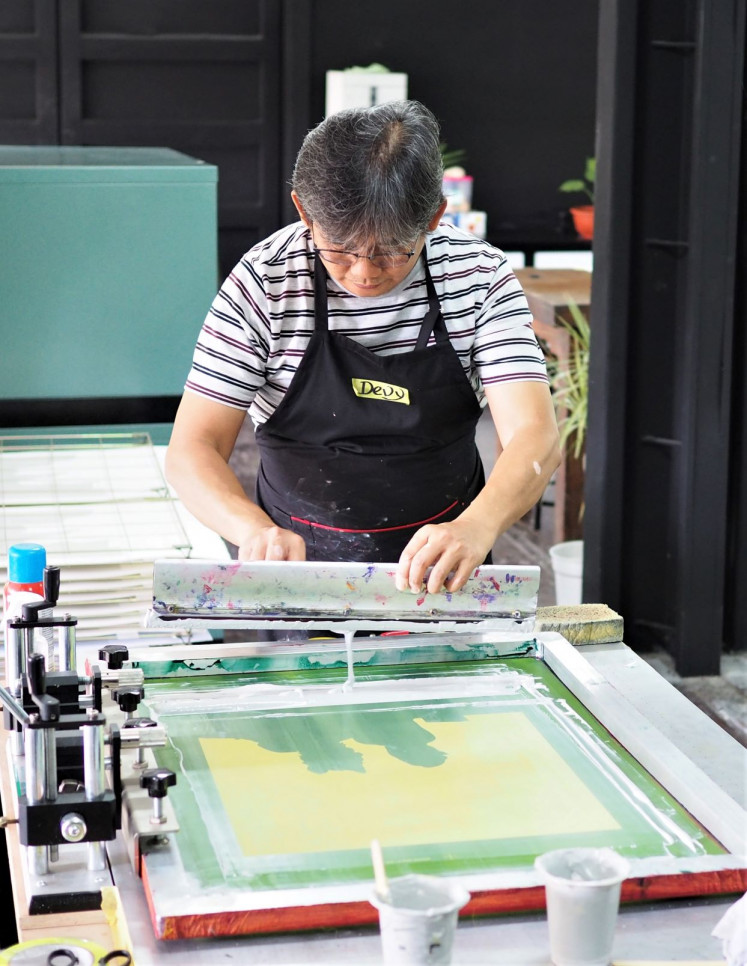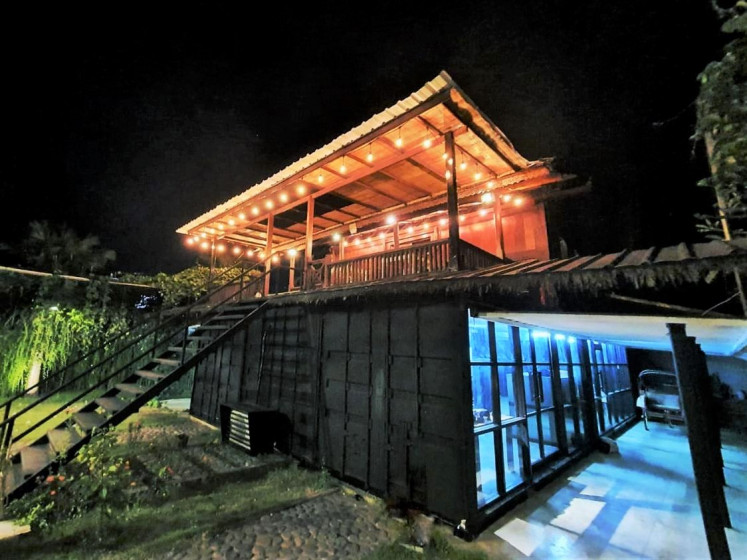Connecting the dots: Printmaking studio invites all to join ‘the gang’
A printmaking studio is offering a chance to own beautiful artwork for an affordable price as it opens customers to the wider world of visual arts.
Change Size

It might be called Black Hand Gang (BHG), but it has nothing to do with street crime.
The printmaking studio in Ubud, Bali, which features old and new in its architectural design of a Javanese wooden joglo house perched atop shipping containers, houses a studio, a shop, a coworking office and a bar. It also houses a group of creative people making artwork prints with their paint-spattered hands.
“We chose a name that might sound scary, like the mob, but actually it [refers to] the creative hands of the printmakers,” cofounder Devy Ferdianto told The Jakarta Post.
The studio opened its doors this June with prints of works of renowned Indonesian artists, from Arahmaiani to Eddie Hara and Sir Dandy. It also prints the work of emerging artists, as well as international guest artists and is in the process of bringing in more, including maestro painter Srihadi Soedarsono.
The studio collaborates with the artists to produce signed, limited edition prints at a quota of only 25 prints for each artwork. The prints are hand pulled by Devy, who is also the studio head, to produce prints that are worlds away from something that has been printed digitally. The artists then sign the prints, which are numbered and come with a certificate of authenticity from the studio.
Artist Eddie Hara, who has achieved both domestic and international success with his works that resemble comic art and carries his signature satirical humor, has contributed two pieces: Destroy Bad Art and Joyful Rites of Spring.
Eddie said that the studio’s prints succeeded in capturing his artistic style and distinctive use of colors.
"My limited edition prints, [printed using] the screen printing technique by BHG studio, are an effort to meet the demand for my original artwork at a price that is still affordable for many people," he said in a statement.
For Arahmaiani, her collaboration with the printmaking studio has allowed her to visualize the possibilities of artwork prints in broadening public appreciation for the visual arts.
"I like the importance of the concept and the idea of the work being [spread among] the public. It could be a ‘breakthrough’ in the visual arts scene in this country that will reduce the exclusivity of the art world because several pieces can be made at affordable prices," said Arahmaiani, one of Indonesia’s seminal and most respected contemporary artists.
Sir Dandy, who is also the frontman of alternative-indie band Teenage Death Star, has lent his iconic piece, a playful and twisted version of the Grimm brothers’ Little Red Riding Hood that has a distinct touch of pop art.
"This work is a modern interpretation of Little Red Riding Hood in which the [girl and the wolf] are actually able to live together in a relationship like a couple. In this work, they are traveling together to the capital of Scotland and visiting several iconic places there," he said.

Devy, who has been dubbed by his team as the “printmaking equivalent of Mr. Miyagi” in The Karate Kid, is no stranger to the contemporary arts scene.
A graduate of the Bandung Institute of Technology in West Java, he pursued further studies at Germany’s Braunschweig University of Art and the Canadian School for Non-toxic Printmaking in Grande Prairie, Alberta.
After he retired in late 2017 as a lecturer at the Indonesia School of Design in Bandung, Devy moved to Bali on what he called “a new printmaking adventure”.
He said printmaking was unique in that it opened more opportunities for exploring the visual and technical compared to other kinds of art. Since more than one print of an original artwork could be produced and the process was mostly done by hand, he said it offered affordable art that was unique to each edition.
“Although it was introduced in Indonesia 70 years ago at universities, printmaking has been slow to develop,” he said.
Devy attributed this slow development to the difficulty in getting materials and equipment, as well as the lack of printmaking studios outside universities. This also made it hard for graphic design graduates to enter the field and as a result, left the public with very few art prints to appreciate.
“We believe that printmaking could develop well if it was done seriously with [...] the proper knowledge, materials and equipment,” he said.

Original prints on paper, however, were not as popular as other art forms like paintings. In addition, collectors were still reluctant to buy and collect art prints, saying that they were difficult to maintain due to the country’s humid climate.
“Another reason [is that] some still think that art prints are reproductions and [so] are reluctant to include them in their collections. Actually, [art prints] are not reproductions. Each edition goes through complicated process that requires attention to detail, so it deserves to be called a multiple-original [artwork],” said Devy.
According to artist and author Phil Metzger in his article at Art Times online art magazine, prints and reproductions both refer to copies of an original artistic work or image, but are created in very different ways. Prints are copies of an original artwork that an artist painstakingly makes, one at a time, while reproductions are mechanically produced, usually quickly and in large numbers, without involving the artist.
The ongoing epidemic may have forced the studio to slow production, but it has continued to expand its outreach. On Oct. 3-10, it held a workshop on Mokulito, a unique ecofriendly lithography method developed 15 years ago in Japan that uses plywood as the medium.
“We’ve just started this studio and we still have many things to develop, especially in printmaking education for the public,” Devy said.









